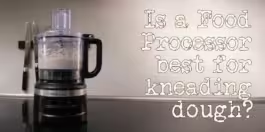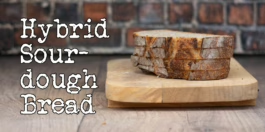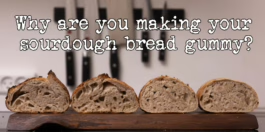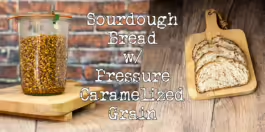Try the new and improved recipe!
The new recipe has been changed based on all the experiments I’ve made on my YouTube channel.
This is the new recipe: Foodgeek Master Recipe for Artisan Sourdough Bread.
Sourdough bread is the bread of bread. Crunchy crust, soft crumb with big holes, and lots of delicious taste. People normally think that it is not possible to make it at home, but it is possible. Here is my sourdough bread recipe for beginners.
I will guide you through making your first sourdough bread. The tools you need. The techniques you need to use to get the perfect bread and everything you need to be aware of throughout the process.
It is actually not very hard to do, but you need to be precise with weighing off the ingredients and following the techniques.
The recipe does not provide precise timings. Instead, I will explain what you need to look for to get bread that tastes fantastic and has a great oven spring.
If you are a sourdough newbie, I hope you will try to make this sourdough bread recipe. You will get off to a great start with this fantastic bread.
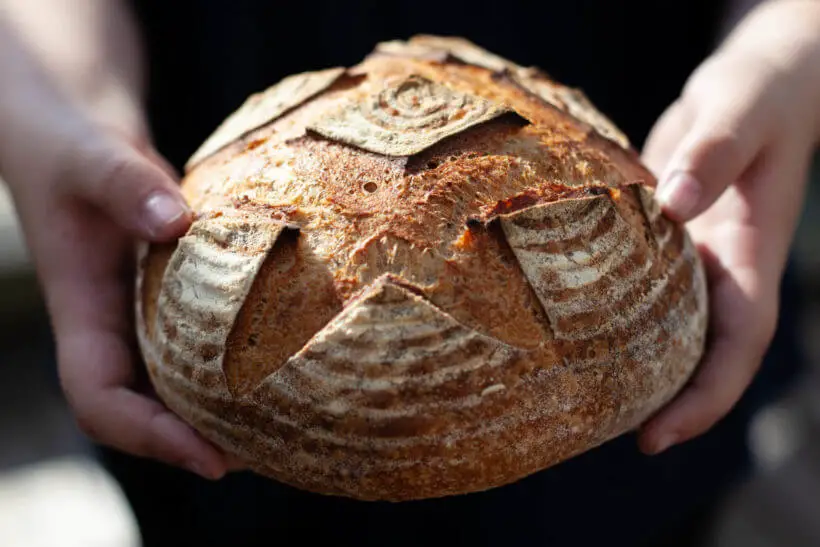
If you are just here for the recipe, you can elegantly skip the entire article by pressing this button:
Jump to RecipeYou need an active sourdough starter
To bake a sourdough bread, you need an active sourdough starter
To bake this bread, you need an active sourdough starter. A sourdough starter is a homemade form of yeast made by attracting wild yeast that is everywhere.
Sourdough starters are living organisms that need to be kept alive, but they are pretty simple to make. I have created a recipe and guide for making your own sourdough starter. If you don’t already have a starter, you should go there and make one before you proceed with this recipe.
Tools to make sourdough bread
Before you start following this sourdough bread recipe, you need to know what tools are essential
I have assembled a list of tools that you need when you bake sourdough bread.
Most of these links will earn me a commission if you purchase the product. If you are not interested in that, you can find the tools using your favorite search engine.
Important tools – need to have’s
As a minimum, you will need:
- A good bowl – This bowl is incredibly beautiful, but whatever you have in your kitchen that is big enough to hold the dough
- A bench scraper – This is used to move the sticky dough around and also to help shape it
- A dutch oven – You need a dutch oven (basically a pot that can go into the oven) because then you won’t have to have to steam the oven because the bread will essentially be steaming itself
- A lame – You need a super sharp knife to score the dough. This one uses a razor blade that can be replaced
- A good oven – Preferably one that can get super hot. I have one that can go to 300°C/572°F and can also steam, which is quite basic in features because I want to do everything manually
Not-so-important tools – nice to have
Other things that are really nice to have, but you can get things done without them:
- A baking steel – Helps keep the temperature in the oven, even when you open the door. It’s also a great help in transferring heat to the bottom of the bread when you don’t use a dutch oven. If you are serious about your bread baking, this is one of the first things you should consider investing in
- Round proofing baskets – They can absolutely be replaced by bowls covered in a dishtowel
- Flour shaker – Helps you put flour on the table or the dough easily.
- Jars for your starter – Love these Weck jars for my starter. Straight sides and good visibility.
- A spray bottle – Or buy a cheap plastic one at your local supermarket. This is just really sturdy and mists the water really good
- A peel – It makes it a lot easier to get a sticky piece of dough into the oven in one piece
- Silicone gloves – These gloves from Oxo are great. Great grip and can withstand a 260°C/500°F warm dutch oven for literally minutes
- Brød and Taylor Folding Proofer – Awesome way to proof your dough, even when your kitchen is a bit cold in the winter
Flour and types of flour
You can use the cheap flour from the supermarket, but to get spectacular results you should invest in quality flour
What wheat flour you are using to bake with determines how good of a result you will get. The most important factor is the protein content. You need to use bread flour with at least 12% protein in this recipe.
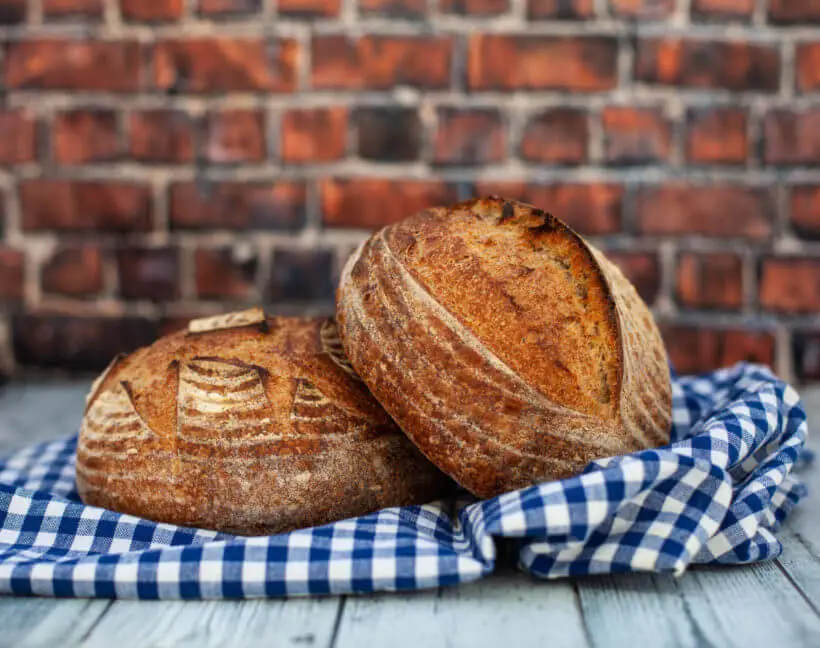
The protein in wheat flour is gluten, and it helps build the structure in the bread. The less protein the flower has, the harder it is for the bread to stay together, and it might spread into a puddle instead of rising up. Especially as you use higher hydrations. Also, less gluten gives a more uniform crumb with smaller holes.
What flours do you use?
I like Canadian Manitoba flour for bread, which has a high protein content and a delicious taste.
In this bread, I’ve used whole-wheat flour from Egeskov mølle, which I bought on my summer vacation to Funen. We visited Egeskov Slot. I’ve been looking forward to trying this flour.
I haven’t baked with these flours myself, but they come recommended on forums and in Facebook groups by people who post their delicious bread:
People in the US can use King Arthur Unbleached Bread Flour and King Arthur Whole Wheat Flour for great results. If you are in the UK, you can use Marriage’s 100% Very Strong Canadian White Flour and Marriage’s Organic Strong Stoneground Wholemeal Bread Flour for great results. If you know of excellent flours in other countries, write to me, and I will add them to this article.
The recipe for this sourdough bread
Good bread comes from having ingredients in the right proportions. I have created a recipe with high hydration but not so high that it would be very hard to handle for a beginner.
The first part of the recipe is a levain, which is essentially a young sourdough. We will use a levain so we can better use the yeast in the starter at the most opportune moment in its growth cycle.
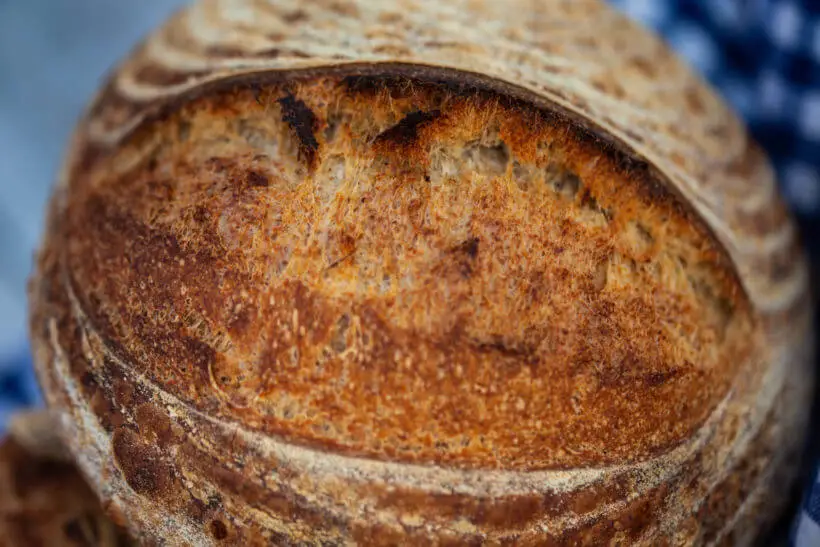
After mixing the dough, the yeast in your sourdough starter starts eating all the food you’ve put in. When it has grown to double size, it’s ready to be used in the dough.
The formula of the levain
The hydration in the levain is 100%. There’s a total of 80 grams of flour and 80 grams of water. Since the sourdough starter is 100% hydrated as well, it does not change the hydration of the levain.
The proportions are as such:
| Weight | Ingredient | Baker's Percentage |
|---|---|---|
| 37g | bread flour | 50.0% |
| 37g | whole-wheat flour | 50.0% |
| 37g | sourdough starter (100% hydration) | 50.0% |
| 74g | water | 100.0% |
I’ve made the levain larger than what you need for the dough; that way, you don’t have to scrape the sides of your container to get enough.
The formula of the bread
The dough’s formula can be seen here. It contains a bit below 20% whole wheat flour, which brings taste and texture to the loaf. There is also enough bread flour in the dough to have lots of gluten, which will help the dough stay together.
There’s a good amount of salt in the dough. That helps bring out more taste. If you want to change it, I wouldn’t recommend you go below 1%.
| Weight | Ingredient | Baker's Percentage |
|---|---|---|
| 686g | bread flour | 81.9% |
| 152g | whole-wheat flour | 18.1% |
| 559g | water | 66.7% |
| 19g | salt | 2.3% |
If you want to change the dough’s hydration, you can use my Bread Calculator™️ here.
The secret behind fantastic sourdough bread
It is not difficult to make fantastic sourdough bread, but there are a few things you need to know
The most important things to making beautiful, tasteful sourdough bread can be summarized into these five rules:
- To develop a fantastic taste, you need to proof and rest the bread for a long period of time. You do that by using autolyse (where only water and flour are mixed and rest for a while) and by letting the bread retard overnight in the refrigerator
- You need to develop the gluten in the dough to get a crunchy crust and soft crumb. That is (also) done by using autolyse and by stretching, folding, and fermenting the dough.
- To get a great oven spring where the bread opens up and out, you need to build a membrane of gluten on the outside of your shaped dough
- You need to bake the bread very hot and with steam for the first 15-20 minutes so that the dough can expand greatly before the crust gets hard
- Last but not least, you need to be courageous not to take the bread out of the oven too early. You don’t want it to get burned, but let it stay long enough to be nice and dark, super crispy and crunchy
Development of gluten in the dough
A strong gluten network is one of the key elements to getting a fantastic oven spring
After you’ve mixed the dough, you need to stretch and fold the dough. This aids the development of gluten but also helps incorporate air into the dough, which gives you those sought-after holes in the crumb. Normally three times is enough, but you must check if the gluten is properly developed.
When you’ve done the last three stretch and folds, you need to check the gluten development. If it is not strong enough, you must perform additional stretch and folds.
To test the gluten development in the dough, you should perform the windowpane test. The goal is to have a dough that is strong enough so you can pull a very thin membrane without the dough breaking:
Shaping of the dough
Another key element in the oven spring is the shaping of the dough. You need to move the dough around on your table using a special technique
When the dough has good gluten development, you need to stretch the top so it forms a tight ball.
To shape the dough, you use your bench scraper, as it helps prevent the dough from sticking to your hards. With the 70% hydration dough we are working with here, it’s not overly difficult, but as you go into the 80s, it gets harder and harder, so I really think you should learn to do this the right way.
As it can be difficult to figure out from a description, I’ve made a video so you can see how it is done:
The scoring of the dough
The scoring of the bread is important because then you get to be the one who decides where the bread expands during baking
When scoring bread, you need a super sharp knife. I use a lame that fits a razor blade, which I often replace.
It’s a good idea to know how you want to score the bread before you start doing it. You must score relatively fast and with conviction to get the best score.
I’ve made two different patterns in my two loaves:
- A diamond-shaped pattern. You get this by scoring three parallel lines and then three other parallel lines that are turned about 30° from the first cuts
- A long cut in the edge of the bread helps the bread open when it’s being baked. This cut is one that creates an ear. Although I find it looks more like an eye
You can see how I perform the long cut here:
Baking of the sourdough bread in this recipe
Here are a couple of tips to bake the perfect sourdough bread in your home oven
To bake beautiful sourdough bread, you will need steam. Professional ovens can inject steam into the oven chamber, but that is still pretty new for domestic ovens. You do not need a steam oven to follow this sourdough bread recipe.
The steam helps the crust stay moist so that the bread can expand more than it would otherwise. That means the bread will rise more before the crust sets, and all those beautiful holes can expand properly.
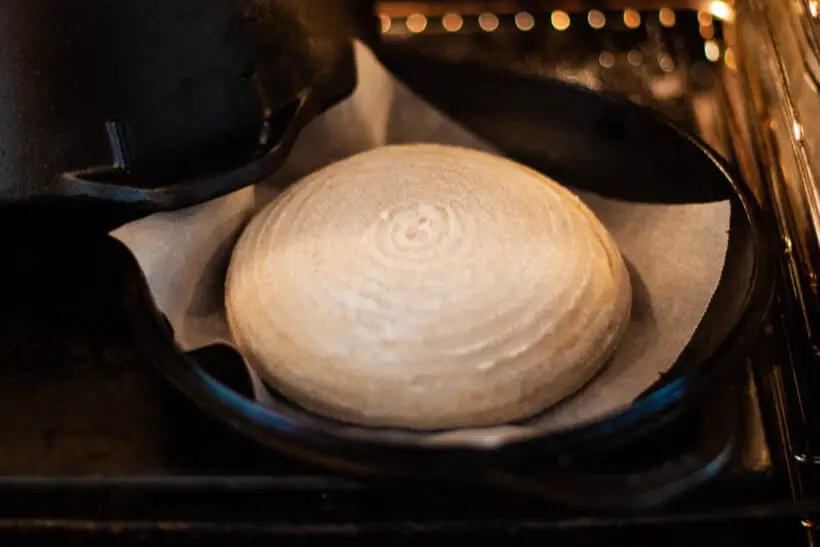
The dutch oven helps the bread steam itself
The bread in this recipe will be baked in a dutch oven (basically a pot that can go in the oven). When the bread is warmed up, the water in the dough evaporates and becomes steam. Because the dutch oven is a confined space, the steam stays directly around the bread and helps the bread rise during the beginning of the baking.
After about 15-20 minutes, the effect is over, and the wild yeast in your starter cannot help the bread expand further. Then you take off the lid of the dutch oven so the steam can dissipate, and the heat in the oven can dry out the crust and make it super crispy.
Cooling the bread is essential to the shelf life of the loaf
I think we’ve all tried cutting into a warm loaf of bread and eating it with copious amounts of melting butter. There are good reasons to wait until the bread has cooled completely, though
When you take your piping hot bread out of the oven and put it on the wire rack, it isn’t done yet.
While the bread’s temperature is declining, the texture is still developing because the starch molecules are releasing some of the water they’ve absorbed during fermentation.
Furthermore, the water that is still in the steam form in the bread will disappear from the bread if you cut a large hole in it while it is still cooling. The bread will then become dry faster, as there is less moisture in it.
What happens when I cut it too early?
If you cut the bread while it is still warm, you risk making the crumb rubbery. It can also be hard to cut without it falling apart.
When the bread has finished baking, it is important to store it correctly. It needs to cool at room temperature and not be covered by anything. If you trap steam from the bread, you risk making the crust soft.
What is the best way to store bread?
When you’ve baked the perfect sourdough bread, it will suck if the bread turns stale quickly because you haven’t stored it right.
- Don’t put the bread in the refrigerator. Refrigerators are pretty dry environments, and bread becomes stale more quickly that way.
- Don’t put your bread in a plastic bag, either. The crispy crust disappears because the bread’s water evaporates. This is the exact same principle that you use in the Dutch oven during baking but in reverse.
I have some bread bags that are made for storing bread, but you can just also wrap the bread in a clean dish towel for the same effect. Last year for my birthday, I got a retro bread box, which also has the same effect and looks much cooler.
Can you freeze the bread?
Sourdough bread is very well suited for freezing. They stay good for at least three months, but I’ve had some that were frozen for 6 months with no ill effect.
I usually cut it into pieces and put some parchment paper between them. Then, you can grab the number of slices you need without having to completely thaw the entire loaf.
I have this KitchenAid toaster, which does a great job defrosting and toasting—it’s absolutely the best I’ve owned. Using this method also allows you to put the toaster on the defrost function, and you get delicious bread in minutes.
To sum up, this sourdough bread recipe
This sourdough bread recipe is high hydration (anything above 65% relative water content) but absolutely at the low end of what is possible to make. The more water relative to flour, the larger the holes and the softer the texture.
When you add more water to the dough, it becomes harder to work with (think pancake dough), so this recipe is an excellent place to start. After mastering all the techniques, you can change to doughs with even higher hydration.
Here is a picture of the crumb in this bread:
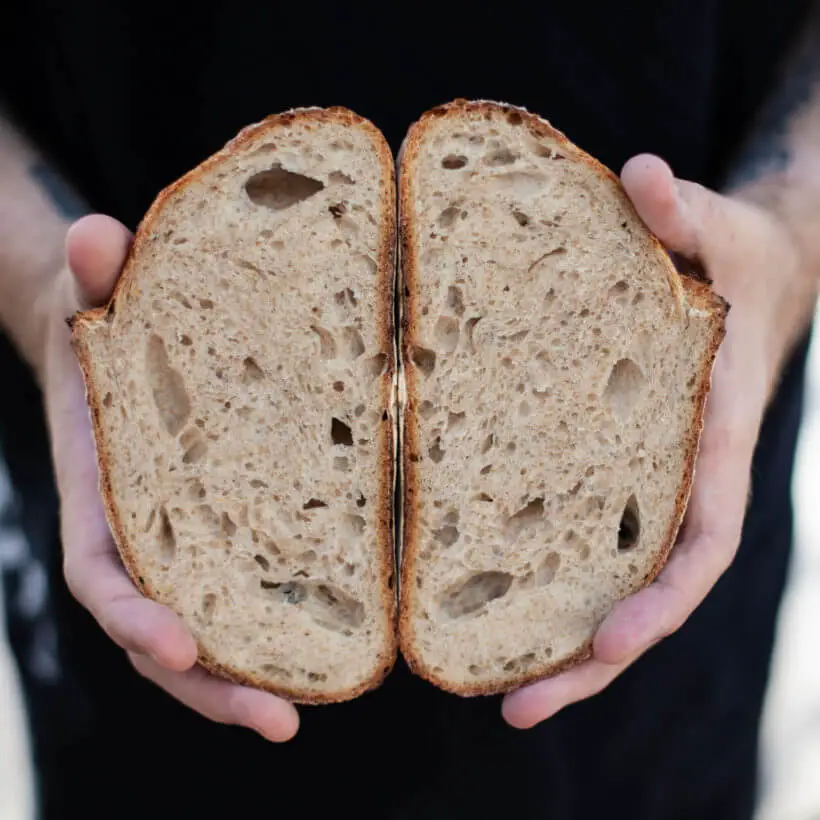
The conclusion
The taste is fantastic. The overnight retarding helped develop a great taste. A bit of a sour note from the starter, but not overwhelming. The whole-wheat flour brings a nutty aroma, and this bread can be eaten just by itself, and it is a pleasure.
The crumb is nice and soft, with medium-sized holes. The crust crunches ideally and is super crispy. It is delicious bread.
Start making fantastic bread at home.
You should try this sourdough bread recipe even if you are a beginner baker. You now have all the knowledge that you need after you’ve read this article.
If you bake this bread and post it on Instagram, please tag me with @foodgeek.dk. So I can see what you’ve made. It would make me very happy.

Sourdough bread for beginners
Ingredients
Levain
- 40 g bread flour
- 40 g whole wheat flour
- 40 g sourdough 100% hydration
- 80 g water
Dough
- 686 g bread flour
- 152 g whole wheat flour
- 559 g water
- 185 g levain
- 19 g salt
Instructions
Levain
- The night before you make the levain, feed your sourdough starter. I usually take 50 grams of sourdough starter and mix it with 100 grams of bread flour and 100 grams of water and mix it well.
- In the morning, you should mix the levain. Mix all ingredients and put it into a tall see-through glass. Put an elastic band around the glass to monitor the growth of the levain.
- Cover the glass and put the levain somewhere warm. Preferably around 25°C/77°F.
- When the levain has grown to around 175%, go to the next step.
Autolyse
- To do the autolyse, we need to mix water and flour.
- Measure out all the flour in a bowl and all the water except 50 grams that we reserve for mixing the levain and salt later. Mix it but don't knead; get all flour hydrated
- Cover the flour and leave it until your levain has doubled in size. It took about 1 hour for my levain.
Mix the dough
- Put 185 grams of levain on top of the dough. Spread the salt over the top and add the reserved 50 grams of water.
- Mix it all very thoroughly. I usually use my fingers and push the levain through the dough and do some light stretch and folds. I keep repeating it until I feel like it's been mixed very well.
- Cover the dough and leave it to rest 30 minutes somewhere warm.
Bulk fermentation
- It's time for bulk fermentation. We develop the dough's gluten during the fermentation. With this dough, three stretch and folds are usually enough.
- Wet your hands so that the dough doesn't stick to your fingers.
- Grab the size of the dough furthest away from you with both hands. Grab hold and strech the dough upwards as long as it can go without breaking. Then fold the dough down towards yourself.
- Turn the bowl 180° (a half turn).
- Do another stretch and fold.
- Turn the bowl 90° (a quarter turn).
- Do another stretch and fold.
- Lastly, you should turn the bowl 180° (a half turn).
- Repeat the last stretch and fold.
- You have now stretched and folded the dough from all four sides. Leave the dough to rest somewhere warm, covered, for another 30 minutes.
- Repeat this process two times more.
- After the third stretch and fold, I will do a windowpane test. Lift and edge of the dough and stretch it with your fingers. You should be able to make a thin membrane without the dough breaking. Look at the video in the article.
- If the dough isn't strong enough to pass the test, I do a 4th stretch and fold and repeat the test. Do this up to the 5th and 6th stretch and fold.
- After the last stretch and fold, you should leave the dough until it's grown by 20-50% (usually 1½ hours).
Preshaping
- First, we are shaping the dough to build a gluten membrane on the outside of the dough. That will help the oven spring during baking.
- Pour the dough unto an unfloured table and divide it in half. Put a sprinkle of flour on top of both.
- Grab a lump of dough and flip it using your bench scraper so that the floured side is now on the table top.
- Grab the part of the dough that is the furthest away from you. Stretch it and fold it down in front of you.
- Repeat with the part that is right in front of you. Grab the dough with both hands, stretch it and fold it away from you. Repeat with the right and left sides of the dough.
- In a swift motion, invert the dough so that the part you previously floured will be facing upwards.
- Put your bench scraper behind the dough and pull it towards yourself. I hold the scraper in my right hand, guiding the dough with my left. The front of the dough should be pulled underneath, and the top of the dough should tighten.
- Now put the scraper in front of the dough and push it forward while twisting so that the scraper ends up behind the dough. You can now repeat the process in the previous step.
- Repeat until you have a nice round and tight ball. Pop any bubbles you see on the surface.
- Repeat with the other lump of dough. Let the dough balls rest for 15 minutes under a cloth.
Prepare the bannetons
- Make a mixture of half bread flour and half rice flour.
- Put a dishtowel in the bannetons. If you don't have one, you can use a bowl.
- Put some of the flour mixture in a strainer and flour the bannetons. It's better to use too much than too little.
Final shaping
- We do the final shaping to make sure the dough is super strong.
- Take a boule and sprinkle it very lightly with flour on the top.
- Flip it using your bench scraper, so the floured side is against the table.
- Repeat the process from the preshaping.
- When you have finished the shaping, grab the boule with your scraper and invert it into the banneton. The bottom should be up.
- Repeat with the other boule and place it in the banneton.
- Sprinkle the dough with rice flour and put the bannetons into separate bags. Make sure you get some air in there so that the plastic does not touch the dough.
- Place in the fridge overnight. Your fridge needs to be cold, so the dough doesn't continue fermenting. I have mine set to 2°C/35°F,
Heat the oven – next morning
- Place a baking stone/baking steel in the oven and put your dutch oven on top. Turn the oven to 260°C/500°F. If it doesn't go that high, put it to the maximum.
- Heat the oven for at least an hour. We want the steel/stone and dutch oven to be thoroughly warmed.
Bake the bread
- Take a banneton out of the fridge.
- Put a piece of baking paper on top of your peel and put it on top of the banneton.
- Turn it over and carefully lift the banneton off the dough.
- Slash the dough using a super sharp knife.
- Open the oven and move the dough to the dutch oven.
- Spray the top of your dough lightly with your spray bottle.
- Put on the lid and close the oven.
- Bake for 15 minutes.
- Remove the lid so the bread can get some color. Turn the oven down to 230°C/450°F. I usually bake it for another 20-25 minutes for this bread. I love it when the crust gets dark and crunchy.
- Remove the bread from the oven and let it cool on a wire rack for at least one hour, but preferably until it is COMPLETELY cooled off.
- Turn the oven back up to 260°C/500°F. When it is hot, repeat the procedure for the other bread.
- All you have to do is wait until the bread are completely cooled off, and get yourself ready for the best bread you've ever baked.
Video
Noter
The hydration of the sourdough starter
I assume that your sourdough is 100% hydration. That means that when you feed it, you use the same amount of flour and water (by weight). If you use a lower or higher hydration, you need to recalculate the levain. It’s a bit over the level of what we are going through here, because this recipe is supposed to be for beginners. If you want play with the breads recipe, you can use my bread calculator here.The hydration of the bread
The hydration of the bread is 70%. That means there is 70% water to 100% flour. You calculate it like this:- The levain is 100% hydration, which means there is 50% flour and 50% water
- Total flour by weight = 686 grams bread flour + 152 grams whole-wheat flour + (185 grams flour / 2) from the levain = 930.5 gram
- Total fluid by weight = 559 grams water + (185 grams water / 2) from the levain = 651.5 gram
- Percent = 651.5 grams water / 930.5 grams flour = 70,01%




